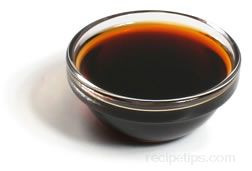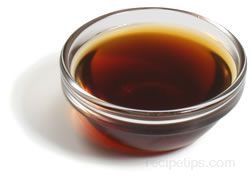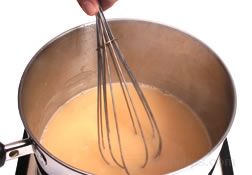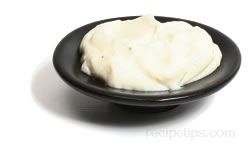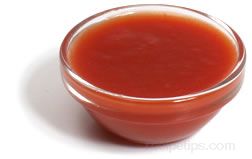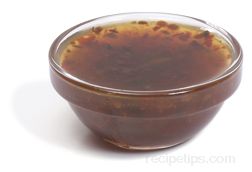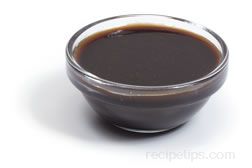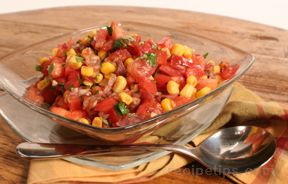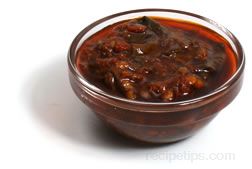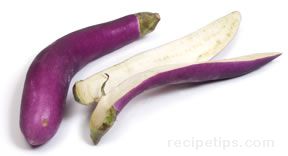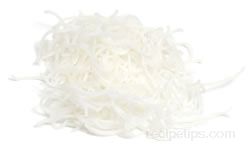Chinese Sauces | Japanese Sauces | Other Asian Sauces
Chinese Sauces
Plum SauceA thick sweet-and-sour Chinese sauce, which is used as a condiment for Asian foods. It is made from a combination of dried plums and apricots, vinegar, sugar, and spices, which provide a sweet tangy and somewhat spicy flavor to foods. The sauce is generally served with duck, pork and spareribs and can be commonly used as a dipping sauce, a seasoning in cooking sauces, or as a glaze on roasts. Also known as duck sauce, it is available in Asian markets and well-stocked grocery stores. |
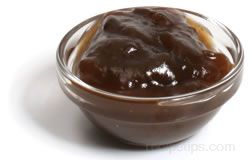 |
Duck SauceA sweet and sour sauce prepared from a combination of dried plums and apricots, vinegar, sugar, and spices, which is served as a condiment with cooked duck or pork. A common sauce for Asian foods, which may also be referred to as plum sauce, provides a sweet tangy and somewhat spicy flavor to foods. The sauce is generally served with duck, pork, and spareribs, as well as being used as a dipping sauce, a seasoning in cooking sauces, or as a glaze on roasts. |
 |
Leek Flower SauceA condiment made from the Chinese Leek Flower, a long thin and very narrow stem that grows a tiny flowering bulb at the top of the stem. Produced to harvest both the stem and the bulb, the Chinese Leek Flower is processed into a condiment that is served over rice dishes or with lamb dishes such as boiled mutton. The Chinese Leek Flower, which is also known as the Chinese Chive, provides a garlic-like flavor with a chive overtone, thus the Leek Flower Sauce adds a similar flavoring when served with meat and rice. |
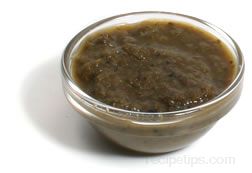 |
Oyster SauceA Chinese seasoning made by cooking a blend of steamed oysters, soy sauce, and salt together until thick and concentrated. The ingredients used may vary according to different recipes. It is used as a condiment, in stir-frying and to season other dishes. Oyster sauce enriches the flavor of a dish without overpowering its taste. It can be found bottled in Asian markets or in well-stocked supermarkets. |
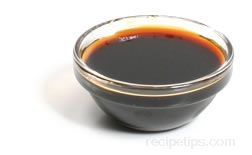 |
Japanese Sauces
Shoyu SauceShoyu is a Japanese word for "soy sauce." Shoyu is a salty brown Asian sauce used as a seasoning or a condiment for Asian dishes. The sauce is made from fermented soybeans, wheat, water and salt. There are two varieties, light and dark. The dark soy sauce is darker in color, thicker in consistency and sweeter in taste than the light soy sauce. The dark soy sauce is used more often in Japanese cooking. The Chinese soy sauce is generally the light soy sauce, which is lighter in color and saltier. The dark soy sauce has a longer life than the light. The light should be used shortly after opening. | |
|
Dark Shoyu |
Light Shoyu |
Ponzu SauceA Japanese sauce that is used as a dipping sauce for poached meats, dumplings, fried foods and seafood; as a sauce added to sautéed foods during cooking, or a salad and cooked greens vinaigrette; or as a dressing for Asian noodle dishes. It is traditionally made by mixing soy sauce, lemon or lime juice, rice vinegar, mirin (sweet rice wine or sake), dried bonito flakes, and kombu seaweed or dried kelp. |
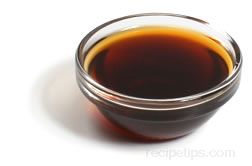 |
Teriyaki SauceA Japanese sauce that is made from a combination of soy sauce, sake, sugar, ginger, and seasonings. The sauce is generally used as a marinade for meats that are then grilled, broiled or fried. |
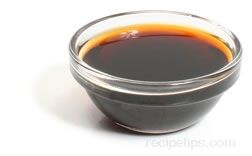 |
Tamari SauceA sauce that is made primarily from soybeans that is used as a condiment for dipping foods or as a basting sauce. It is created as a liquid when miso, which is a soybean paste, ripens as it ferments. Similar to soy sauce, Tamari is mild flavored, contains little or no wheat, but is thicker in consistency. It is brewed over a longer period of time, sometimes up to six months, giving the Tamari a smoother flavor than soy sauce. | |
Other Asian Sauces
Soy SauceSoy sauce is a salty brown Asian sauce used as a seasoning or condiment to enhance and harmonize the flavors of various foods. It is a sauce that is used to bring out the flavor in foods, such as meats, poultry, fish, and cheese. The traditional soy sauce, typically considered as an Asian condiment, is made from fermented soybeans, ground roasted wheat, and a starter mold known as koji to begin the fermentation. A brine of sea salt and water are added after the original mixture has aged for 3 to 5 days. This combination of ingredients is then seasoned again and allowed to mature for approximately 6 months after which it is pasteurized and prepared for commercial use. |
|
|
In Japan, soy sauces are referred to as shoyu, or in Chinese, they are called pinyin jiàngyóu (Mandarin) and see yau (Cantonese). There are a number of different varieties made, of which there are basically two different categories, referred to as either the light or the dark sauces. Dark soy sauce is darker in color, thicker in consistency and sweeter or richer in flavor than the light soy sauce. Dark soy sauce, which typically contains molasses and other seasonings, is used most often in Japanese or Chinese cooking for stir fry marinades, meat glazes and to flavor stews. Chinese dark soy is a traditional dark soy sauce, which is very thick in texture and contains molasses as a main ingredient. Another dark, thick textured sauce made with an Asian dark soy sauce, is Kecap Manis or Ketjap Manis, which contains palm sugar, star anise and garlic as flavorings. This sauce is a common condiment, marinade and flavoring for Indonesian food dishes. A version of soy sauce that may be referred to as "wheat free" is the Japanese Tamari, a strong flavored sauce processed either as a sauce made only from soybeans or as a sauce containing only a small amount of low quality wheat. Tamari is thick in consistency, stronger flavored than traditional Chinese sauces, and is generally used as a sauce for raw fish or a cooking sauce for dishes with longer cooking times, such as stews, soups and cooked meat dishes. However, it can also be used as a marinade sauce, a salad dressing, or as a seasoning and dipping sauce. Flavored soy sauces are also available, such as mushroom soy sauce, made with dried mushrooms and considered to be a dark soy sauce. The mushroom sauce has an earthy flavor that goes well with meat stews and marinades. The light soy sauces are lighter in color, thinner in texture, saltier in flavor, and contain more of the sour overtones than other soy sauces. The Japanese word for this type of soy sauce is "shoyu," which is a sauce typically made from soybeans, roasted wheat, sea salt, water, and koji starter mold. The lighter sauces, which will generally not alter the color of the foods being prepared, are traditionally used when cooking vegetables, clear soup, soup bases for noodles, and white fish. Since light soy sauces have a shorter shelf life than the darker sauces, they should be used shortly after opening. The alternative to a traditional fermented sauce is the hydrolyzed soy sauce, but it often lacks the full flavor of the natural or traditional sauces. Hydrolyzed soy is a synthetic sauce that has not been brewed in the same manner as a naturally brewed soy sauce. Soy sauces can be used in salad dressings, as well as an ingredient for many other sauces, such as marinades, steak sauces, barbecue sauces, or as flavorings in soups, stews, and a variety of food dishes. | |
Hoison SauceA popular thick sauce used for Asian foods, both as an ingredient in cooking and also as a condiment. It is made from fermented soybeans, garlic, chilies, vinegar, sugar, and various spices that provide a sweet and somewhat tangy flavor. There are different brands of this sauce that vary in consistency and flavor, some being less sweet and spicy than others. |
 |
| If used for cooking, the sauce is often brushed onto meats prior to being broiled or grilled. It can be added to meats and other ingredients as they are stir-fried or used as a dipping sauce. Since it contains a higher level of sugar than many other sauces, it is best to use caution when applying heat, making sure not to burn the sauce as it cooks. Keep unused sauce refrigerated and it can then be kept for very long periods of time without losing much flavor. | |
Fish SauceAn amber red to reddish-brown colored sauce produced as a liquid byproduct from fermenting salt-cured fish. In some countries such as the Philippines, an Asian food known as bagoong monamon is is prepared first in order to produce a fish sauce referred to as patis, which becomes the byproduct of making bagoong. But bagoong monamon can also be considered a type of fish sauce, since bagoong is basically a flavoring for other foods, which fish sauce is as well. |
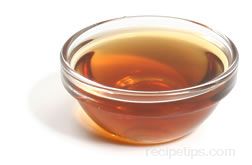 |
|
Some sauces are clear in consistency as they are often removed or refined from a more dense mixture of cured fish, while others are cloudy and appear more like a pureed food substance. Bagoong has the opaque or pureed consistency and often is produced with whole anchovy filets in the sauce to improve the flavor. Many fish sauces are made with anchovies which are the species of fish typically prepared to produce bagoong monamon. However, other varieties or combinations of fish are also used to make fish sauce, such as mackerel, tuna, shrimp, and squid. Sauces made with 100% of a specific variety of fish, like anchovies, are considered to be the best tasting of the fish sauces. Fish sauce has a sharp, salty taste with a strong aroma that is used as a seasoning or condiment to enhance the flavor of various foods. It is popular in Southeast Asian dishes and can be found in many Asian markets. The traditional fish sauce is known as nuoc nam in Vietnam, patis in the Philippines, Nam pla in Thailand, and shottsuru in Japan. Fish sauce may also be referred to as fish gravy in some regions. Fish sauce is generally not served separately as a topping sauce or seasoning due to its overpowering flavor. Instead, it is most often used on foods that may have already been flavored with other seasonings or sauces. And, if desired, it can be tempered by adding sugar and lime juice to make it less intense in flavor for use as a dipping sauce with vegetables or wrapped foods, such as spring rolls. | |
Bean Paste or Bean SauceA type of seasoning made from fermented or germinated soybeans that are used to flavor a variety of Asian foods. Bean pastes and sauces are common in Asian cooking and are often used as a base sauce from which other types of pastes or sauces are developed. Combining a bean sauce with hoisin sauce or a hoisin sauce with chili bean paste enhances the flavor of the sauce and the food to which it is added. Bean pastes and sauces are used to flavor hot or spicy tasting food dishes and are often combined with chili peppers or other seasonings to intensify the heat and taste. Poultry, meat, noodles, pork, and vegetables are all foods that are frequently seasoned with bean sauces. |
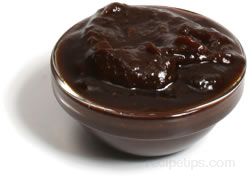 |
|
There are many different types of bean pastes and sauces made for use in Asian cooking such as chili bean pastes made in red, green, yellow, or roasted varieties, bean sauces made in yellow or brown varieties, and chili bean sauce made as a red sauce. In addition, within all the varieties, there are different textures (from thick to thin), different intensities of heat (from mild to hot), and different levels of sweetness. Black bean sauce contains ground black beans combined with seasonings such as garlic and at times star anise. The pastes and sauces labeled as hot such as hot black bean sauce will often contain chilies to provide the heat combined with the ground beans, garlic seasoning and sugar. Yellow bean sauce which contains yellow beans and is brown in color is basically the same as brown bean sauce or ground bean sauce. Chili bean sauce is a salty flavored sauce containing chili peppers, fermented soybean paste, possibly fermented broad bean paste, sugar, garlic, and other seasonings. Bean paste or sauce is typically sold as a sauce made with either whole beans or crushed (mashed) beans that have been ground into a puree-like texture. The pastes and sauces made with whole beans are typically labeled as bean sauce or bean paste, which are mixtures containing the whole beans processed into a thick paste or sauce, which may be sweetened or unsweetened. These pastes and sauces are generally the preferred types of mixtures since they have more of the soy flavor and texture that is similar to the traditional soy sauces. Beans that have been crushed are most often puréed, as they are ground or mashed into a smoother texture and labeled as a yellow or crushed bean sauce. The crushed bean sauces are saltier tasting than the whole bean sauces. Other names often used for the pastes or sauces may include brown bean sauce, bean paste, soybean sauce or soybean condiment. For storage, keep opened paste and sauces stored in an airtight plastic or glass container placed in the refrigerator. Storing for several months is acceptable and use by the date displayed on the label. | |
Asian Chili SauceA type of condiment that is somewhat similar to the Chile Sauces produced in countries such as Mexico and the U.S. Often referred to as either a Sauce or a Paste, Asian Chile Sauces can contain any one of many different chili peppers used to produce the sauces, which provide numerous variances in flavor and heat intensity. Some ingredients commonly used to produce an Asian Chile Sauce or Chile Paste may include soybean or palm oil, herbs such as basil, garlic, sugar, and other seasonings to produce a somewhat sweet and spicy flavored red, green, yellow, or brown colored Chili Sauce. |
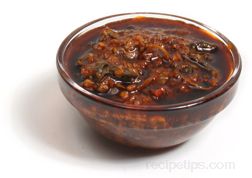 |
| Many US and Mexican Chile Sauces use tomatoes and chilies as a base while the Asian Chili Sauces and Pastes most often do not use tomatoes, so there is less of a lighter water-like texture and more of an oily consistency to the Asian Sauces. All types of Chile Sauces are commonly served as toppings for red meat, poultry, fish, and egg dishes, while Asian Sauces and Paste are commonly used during the preparation and cooking of the foods as well as a topping or dipping Sauce. | |
Maggi® SauceAn Asian sauce, made from vegetable proteins combined with salt, pepper and various spices, that is used as a food flavoring. Commonly found in food stores, Maggi® Seasoning is used as an ingredient with stir-fried foods, cooked vegetables, noodle or rice dishes, salads, meats, and poultry. Versatile in use, it is served as a dipping sauce, it can be made into a marinade or it is simply added as a seasoning sauce to a variety of foods. This sauce provides a flavor that is very similar to a sweet soy sauce. |
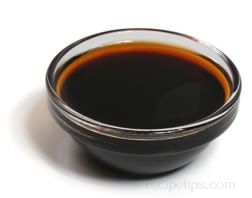 |
Banana SauceAn Asian condiment that has the same appearance and flavor as tomato ketchup. Made with bananas, water, sugar, vinegar and seasonings such as garlic, onions, salt, and spices, this sauce is produced as an alternative to ketchup for regions that grow significant numbers of bananas. |
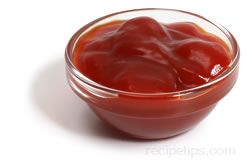 |
Peanut SauceA popular sauce in Southeast Asia which is made from peanut oil, peanut butter or ground peanuts, garlic, onions, chilies, and soy sauce. Peanut sauce is served with dishes such as tofu, satay dishes, and gado-gado where it may be considered a dipping sauce, a dressing or in some instances altered to be used as a marinade. |
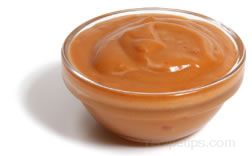 |
Sriracha SauceThai chili sauce, sold commercially in a mild or hot form, which is similar to an orange-red ketchup and used in cooking or as a condiment. | |





